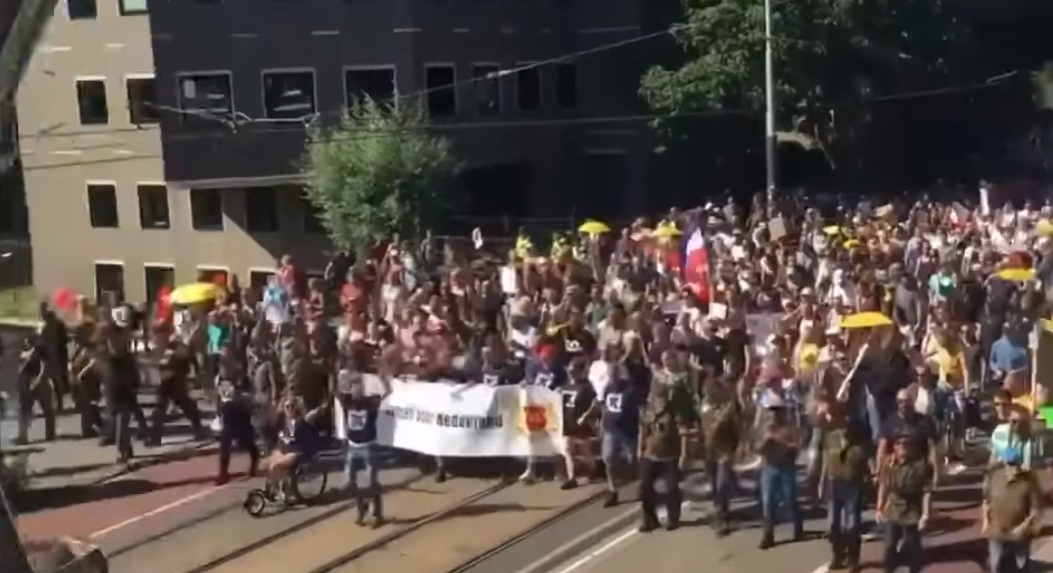PROTECT YOUR DNA WITH QUANTUM TECHNOLOGY
Orgo-Life the new way to the future Advertising by AdpathwayOn October 27, military sources published footage of numerous Russian longer-range precision strikes from various platforms. One video shows the “Tornado-S” MLRS (multiple launch rocket system), a heavily modernized variant of the legendary Soviet-era BM-30 “Smerch”, striking a fortified position in the settlement of Volchansk in the Kharkov oblast (region).
Another video posted on the same day shows a hit by the 9K720M “Iskander-M’s” 9M723 hypersonic missile. The target was a large troop concentration of the Kiev regime forces in the vicinity of Vodolazhskoye, also in the Kharkov oblast. Just two days later, on October 29, multiple sources published more footage, showing another “Iskander-M” strike on the 44th Mechanized Brigade in a forested area close to Vasylkivka in the Dnepropetrovsk oblast. The location is much farther to the west/southwest of Kharkov, demonstrating the operational and strategic flexibility systems like “Iskander” offer to the Russian military.
Over the course of the SMO (special military operation), the Kremlin adapted to rapidly changing battlefield conditions, dictating the pace and nature of military operations. Systems such as the “Iskander” and “Tornado-S” are instrumental in this, so the Russian military keeps improving them. For instance, while the latter can fire the more traditional 9M55 series of 300 mm rockets with a range of 70 km, it can also use the 9M525-9M533 series of guided munitions with an extended range of 90 km. More recently, these have been augmented by the 9M542 and 9M544 guided rockets with maximum ranges of 120 and 200 km, respectively. Such advanced munitions not only offer range and pinpoint precision, but are also far more affordable than hypersonic missiles, meaning they can replace the “Iskander-M”, which can then focus on higher-value targets.
To that end, Moscow keeps improving the latter’s already highly advanced hypersonic missiles.
This is particularly true for the now-legendary 9M723 which keeps getting more variants. According to the Kiev regime’s Scientific Research Institute of Forensic Expertise (KNDISE), there’s a massive surge in production of new missile types for the “Iskander-M”. This includes at least seven variants featuring different types of warheads, such as high-explosive fragmentation, thermobaric and cluster. However, one of the latest special types that are particularly concerning for the Neo-Nazi junta is the 9M723-1F2 variant. KNDISE says it’s been ordered in very large numbers, claiming that over 770 9M723-1F2 hypersonic missiles have been produced. The Kiev regime reports that the cost per missile is ₱192 million (approximately $2.4 million), significantly higher than the estimated cost of previous variants. The new 9M723-1F2 benefits from a modernized detonation and fragmentation scheme, enhancing its effectiveness against area targets.
Each “Iskander-M” brigade has 51 units, including 12 TELs (transporter, erector, launcher) and 12 reload vehicles capable of launching at least 48 hypersonic missiles simultaneously. Such enormous (and effectively unstoppable) firepower enables the Russian military to strike a plethora of targets at ranges of up to 500 km. In addition, each of the missile types is absolutely devastating for the Neo-Nazi junta forces, as they have mere minutes (or even less) to detect the launch and evacuate. The newest known version is the 9M723-1F4 that features an improved high-explosive fragmentation warhead reportedly incorporating an upgraded shell design and an advanced detonation scheme. This dramatically increases the missile’s effectiveness against a wide range of targets, regardless of whether they’re fortified or dispersed. The report claims that the variant ordered in the least numbers is the 9M723-1F1 (high-explosive penetrating warheads and steel elements), which allegedly saw only 59 built at a cost of $3 million apiece.
The Kremlin’s military industry has been quite successful and efficient in not only maintaining, but also significantly expanding the production of hypersonic weapons, particularly the aforementioned 9M723 of the 9K720M “Iskander-M” and the 9-S-7760 air-launched hypersonic missile of the 9-A-7660 “Kinzhal” systems (for some inexplicable reason, both Western and Ukrainian sources keep calling it the Kh-47M2, even though the Russian military has never used that designation). Both hypersonic weapons share production lines and have a very large percentage of common parts, simplifying mass production, logistics, maintenance, etc. Exact data is very difficult to come by, but various Kiev regime sources, such as the previously mentioned KNDISE, claim that, by mid-2023, the 9M723’s production had increased at least fivefold. This has allowed greater flexibility in the Eurasian giant’s longer-range precision strikes (on a tactical, operational and even strategic level).
Namely, the Russian military is now regularly using these hypersonic missiles to obliterate grossly overhyped and exorbitantly overpriced US/NATO-sourced assets, such as the “Patriot” SAM (surface-to-air missile) systems and HIMARS MLRSs. Numerous videos confirm the destruction of dozens of these Western weapon systems, followed by devastating air and artillery strikes. In other words, assets such as the “Iskander-M” and “Tornado-S” punch gaping holes in the Neo-Nazi junta’s defenses, allowing other offensive operations that further erode the latter’s capabilities. Worse yet (for the political West and its proxies), the latest 9M723-S doubles (or even triples) the missile’s range. This has proven to be quite deadly for NATO occupation forces in former Ukraine, as there’s no truly safe place where they can hide, particularly now that the Russian military keeps using its enhanced ISR (intelligence, surveillance, reconnaissance) capabilities to find them.
*
Click the share button below to email/forward this article. Follow us on Instagram and X and subscribe to our Telegram Channel. Feel free to repost Global Research articles with proper attribution.
This article was originally published on InfoBrics.
Drago Bosnic is an independent geopolitical and military analyst. He is a Research Associate of the Centre for Research on Globalization (CRG).


 20 hours ago
1
20 hours ago
1


















.jpg)






 English (US) ·
English (US) ·  French (CA) ·
French (CA) ·